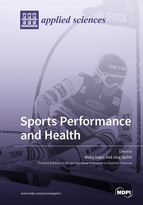Sports Performance and Health
A special issue of Applied Sciences (ISSN 2076-3417). This special issue belongs to the section "Applied Biosciences and Bioengineering".
Deadline for manuscript submissions: closed (30 September 2020) | Viewed by 89101
Related Special Issue: Sports Performance and Health II
Special Issue Editors
2. Swedish Winter Sports Research Centre, Department of Health Sciences, Mid Sweden University, 831 25 Östersund, Sweden
Interests: biomechanics of sports; sports measurements technology; sports performance; injury prevention
Special Issues, Collections and Topics in MDPI journals
Interests: sports performance enhancement and sports injury prevention
Special Issues, Collections and Topics in MDPI journals
Special Issue Information
Dear Colleagues,
Sports performance is predominantly associated with elite sport, where athletes strive for a place on the podium, the most prestigious of which is probably an Olympic gold medal. On the other hand, it is becoming more frequent that recreational athletes attempt to mimic elite athletes by trying to push their limits ever higher. Both elite and recreational athletes, therefore, attempt to optimize their performance, but such optimization is associated with increased risk of injury. Therefore, despite the well-known positive health effects of physical activity, the prevention and management of sports-related injuries remain major challenges to be addressed. Treating sports injuries is often difficult, expensive, and time-consuming, and, thus, preventive strategies and activities are justified on the basis of both medical as well as economic grounds. We are interested in manuscripts that examine sports performance- and health-related issues. Potential topics include, but are not limited to, the following:
- Benefits of sport to health
- Tradeoffs between sports performance and health
- Optimization of sports performance by training, technique and/or tactics enhancements
- Prevention and management of sport injuries
- Optimization of sports equipment to increase performance and/or decrease the risk of injury
- Innovations for sports performance, health, and load monitoring
PD Dr. Jörg Spörri
Guest Editors
Manuscript Submission Information
Manuscripts should be submitted online at www.mdpi.com by registering and logging in to this website. Once you are registered, click here to go to the submission form. Manuscripts can be submitted until the deadline. All submissions that pass pre-check are peer-reviewed. Accepted papers will be published continuously in the journal (as soon as accepted) and will be listed together on the special issue website. Research articles, review articles as well as short communications are invited. For planned papers, a title and short abstract (about 100 words) can be sent to the Editorial Office for announcement on this website.
Submitted manuscripts should not have been published previously, nor be under consideration for publication elsewhere (except conference proceedings papers). All manuscripts are thoroughly refereed through a single-blind peer-review process. A guide for authors and other relevant information for submission of manuscripts is available on the Instructions for Authors page. Applied Sciences is an international peer-reviewed open access semimonthly journal published by MDPI.
Please visit the Instructions for Authors page before submitting a manuscript. The Article Processing Charge (APC) for publication in this open access journal is 2400 CHF (Swiss Francs). Submitted papers should be well formatted and use good English. Authors may use MDPI's English editing service prior to publication or during author revisions.
Keywords
- Biomechanics
- Physiology
- Psychology
- Material science
- Sports medicine
- Injury prevention
- Injury risk
- Olympic sport
- Competitive sport
- Recreational sport







